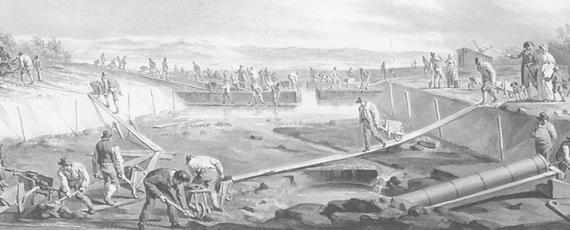History
Haarlemmermeer has a long history. At the beginning of the 16th century, three lakes situated between Amsterdam, Haarlem and Leiden merged to form the largest lake in the province of North Holland. It became known as the Haarlemmermeer. For centuries, this lake’s wild nature constituted a threat to the surrounding villages and towns such as Leiden and Amsterdam. Something had to be done to neutralise this threat and that was how the idea of draining the Haarlemmermeer was born.
Draining the polder
During the storms of 1836, water lapped against the city gates of Leiden and Amsterdam. This led to the signing of the Haarlemmermeer Drainage Act by King William 1 on 22 March 1839. After that, a committee was set up whose members included the engineer, M.G. Beijerinck. Work started on 5 May 1840 behind the Treslong farmstead near Hillegom. This signalled the start of the excavation of the 60 kilometre-long Ringdijk and Ringvaart.
King William II decided that Haarlemmermeer should be drained using steam power provided by a Cornish Engine from the county of Cornwall in England. Three steam pumping stations were purchased, each of which generated 360 horse power. They were known as the Leeghwater, the Cruquius and the Lijnden. The Leeghwater was put into operation in June 1848. From April 1849 onwards, assistance was provided by the Lijnden and the Cruquius steam pumping stations. After three years of pumping, the lake had at last been drained by 1 July 1852.
In 1853, a decision was taken to establish two villages. These two new villages were originally named Kruisdorp and Venneperdorp. They were later renamed Hoofddorp and Nieuw-Vennep. Haarlemmermeer became an independent municipality on 11 July 1855. It was only sometime after the Second World War that this poorly accessible area became one of the most important municipalities in the Netherlands.

Keeping the area drained
During the storms of 1836, water lapped against the city gates of Leiden and Amsterdam. This led to the signing of the Haarlemmermeer Drainage Act by King William 1 on 22 March 1839. After that, a committee was set up whose members included the engineer, M.G. Beijerinck. Work started on 5 May 1840 behind the Treslong farmstead near Hillegom. This signalled the start of the excavation of the 60 kilometre-long Ringdijk and Ringvaart.
King William II decided that Haarlemmermeer should be drained using steam power provided by a Cornish Engine from the county of Cornwall in England. Three steam pumping stations were purchased, each of which generated 360 horse power. They were known as the Leeghwater, the Cruquius and the Lijnden. The Leeghwater was put into operation in June 1848. From April 1849 onwards, assistance was provided by the Lijnden and the Cruquius steam pumping stations. After three years of pumping, the lake had at last been drained by 1 July 1852.
In 1853, a decision was taken to establish two villages. These two new villages were originally named Kruisdorp and Venneperdorp. They were later renamed Hoofddorp and Nieuw-Vennep. Haarlemmermeer became an independent municipality on 11 July 1855. It was only sometime after the Second World War that this poorly accessible area became one of the most important municipalities in the Netherlands.
The economic centre of the Netherlands
The Second World War was followed by a period of reconstruction. It was a time when economic activities developed at an unprecedented rate. Many companies from the Randstad conurbation set up business in the Haarlemmermeer area, attracted by its favourable location and the opportunities it offered for expansion. This led to the new national airport being opened in the area in 1967. Schiphol provides employment in the Haarlemmermeer polder. At the same time, it acts as a magnet for other businesses. The growth of Schiphol (which now processes around 49 million passengers every year) therefore had an effect on the surrounding business community. The infrastructure also changed and resulted in the construction of the country’s key traffic arteries for both motorways and public transport. Haarlemmermeer started to take shape as an economic centre and, had become a leading residential and business area too.
